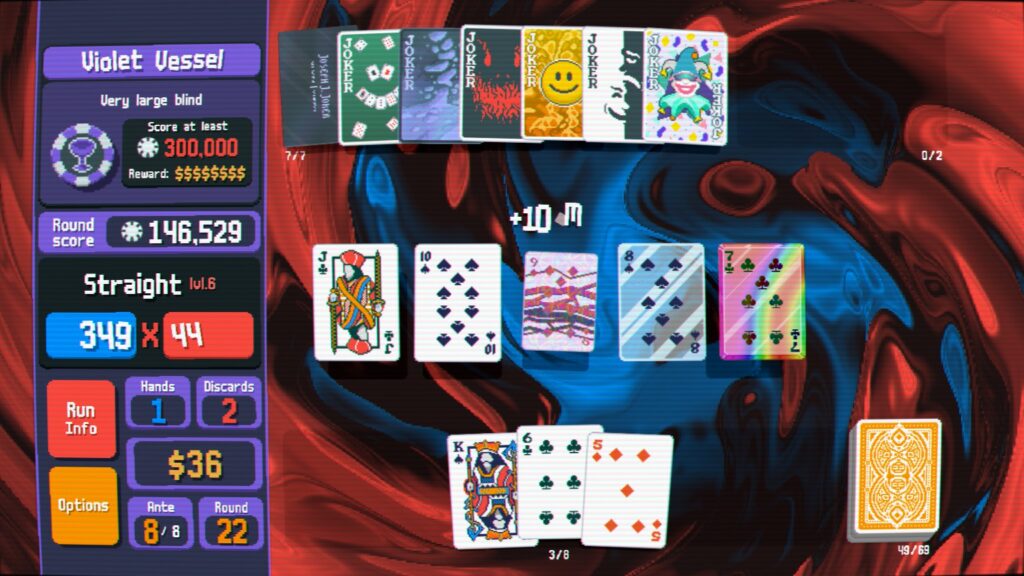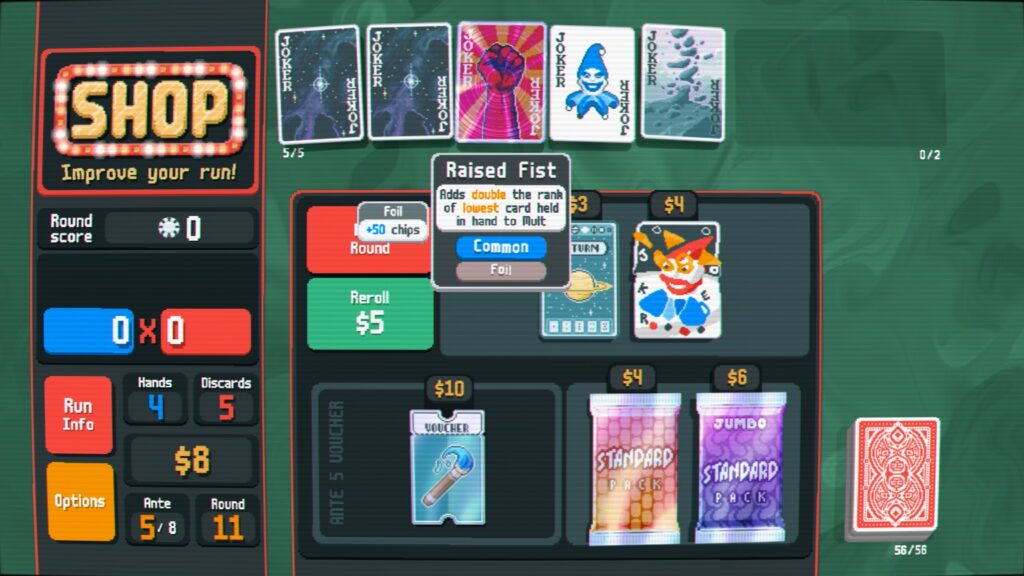Balatro was one of many games I had a chance to check out from next fest that I knew was going to be a hit, but I was surprised to see how much of a hit the game became. Combining deck builders and roguelikes is not new, but the mix of poker provided something else to the formula that I wanted to look at closer.
52 Card Rogue
There isn’t a story to Balatro, we are fighting against blinds in what I assume is some kind of casino; playing the most unorthodox game of poker. Your job is to play enough hands to get chips to cover the blind; do so, and you move on to the next round, fail, and it’s game over. You start with the same 52-pack of cards that everyone knows by now.
While the game does feature poker hands, poker terminology, and you have to technically play poker to win, this is not a poker game. If you are someone who is really good (or really lucky) at poker and get the best hands every time…you’re going to lose. As you go through the rounds, the requirements for winning quickly go into the tens of thousands for chips, and there is literally no way to earn that amount on your own with just poker. To win, you must embrace the roguelike design and start messing with the rules.
Joker’s Wild
The key to winning Balatro is the use of jokers, and while they aren’t technically allowed in real poker, here, they’re going to help you out. The jokers are Balatro‘s versions of artifacts or relics in any roguelike/roguelite and provide passive benefits under specific circumstances. The main thing that jokers will do is raise your multiplier rating. To determine how many chips you get after playing a hand, the game will take the chips of the hand, the chip value of the cards, and then multiply it based on the respective multiplier.
With jokers, they can greatly increase the multiplier and can lead you from earning tens of chips, to ten thousands of chips if you play your cards right…literally. You can only have five jokers equipped by default at any one time and joker powers can combo off each other as well.
The beauty of this design is that the jokers are built to be very spiky in terms of their effects, and this is on purpose. Good roguelike design is about building content that can go in a variety of directions to create variance, and Balatro does just that. Anyone who has played a deck builder knows about how passives can lead to overpowered runs or just be enough to get a win, but that language is often tied up with the rules and effects unique to that game.

Balatro features very advanced deckbuilding, streamlined into poker rules
Here, we have the simplest card designs in the world — a card has a number and a suit; that’s it. It’s far easier to understand something boosting all jacks, or all spades, as opposed to a power that multiplies bleed effects on all zombie class monsters in a range of 1-4.
The jokers effectively become your build for the run, and how you manage them with your cards is what leads to the best feeling in these games — destroying the game itself.
Breaking the House
Learning the language of the jokers is the first step, but then applying that to the rest of your deck is where Balatro comes to life. You can add and remove cards from your deck, change their suit, and upgrade cards and hands. Cards can be upgraded to have additional effects when played and these can stack.
You are still trying to score poker hands, but at some point in your run, the act of playing poker is kind of secondary to winning at poker. In one of my plays, I got a joker that gives a free multiplier based on the smallest card in my hand, at that point, I could stop caring about playing actual hands when I could just empty my hand and get free multipliers with my face cards.

Success is not about playing poker, but using all your cards to break the game
And once again, that is the entire point. In an interview I did with Edward Mcmillen on the Binding of Isaac, part of his design philosophy was to provide the player with as many ways of breaking the game as possible. The reason is that the chance the player is going to get “the one way” each time is not going to happen, and it makes the player feel good when the stars align and their run comes to life.
The Card Trick
Balatro is a great example of making an approachable roguelike and deckbuilder with the crunchyness that fans of the genre have come to expect. Like Hades before it, this is a game that softens the edge of a roguelike and presents it in a way that is appealing to everyone. You don’t need to enjoy poker or deckbuilders to play Balatro, but the combination here has created a very engaging game.
If there are lessons to take away is that depth is always better than complexity. Part of the success of Luck be a Landlord was on this very notion of streamlining deck builders into something that may have less control, but still has the depth of creating a build. This topic is going to come back up in a later post I’ve been thinking about with the strategy genre.
Here’s my interview with Edmund Mcmillen
For more on Roguelike design, be sure to read my book “Game Design Deep Dive: Roguelikes.”
- If you would like to support what I do and let me do more daily streaming, be sure to check out my patreon.
- My discord is now open to everyone for chatting about games and game design.
